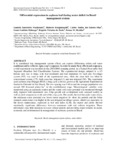Use este identificador para citar ou linkar para este item:
http://www.alice.cnptia.embrapa.br/alice/handle/doc/1007396Registro completo de metadados
| Campo DC | Valor | Idioma |
|---|---|---|
| dc.contributor.author | MARTORANO, L. G. | pt_BR |
| dc.contributor.author | BERGAMASCHI, H. | pt_BR |
| dc.contributor.author | DIAS, C. T. dos S. | pt_BR |
| dc.contributor.author | DALMAGO, G. A. | pt_BR |
| dc.contributor.author | FARIA, R. T. de | pt_BR |
| dc.contributor.author | HECKLER, B. M. | pt_BR |
| dc.date.accessioned | 2015-02-13T09:09:14Z | - |
| dc.date.available | 2015-02-13T09:09:14Z | - |
| dc.date.created | 2015-02-02 | pt_BR |
| dc.date.issued | 2014 | pt_BR |
| dc.identifier.citation | International Journal of AgriScience, v. 4, n. 1, p. 1-15, Jan. 2014. | pt_BR |
| dc.identifier.issn | 2228-6322 | pt_BR |
| dc.identifier.uri | http://www.alice.cnptia.embrapa.br/alice/handle/doc/1007396 | pt_BR |
| dc.description | It is considered that management system effects can express differences within soil water conditions and be reflected upon crop?s responses. In order to assess these effects and responses, a field experiment was installed during 2003/2004 cropping period, in a Typical Dystrophic Red Argissoil (Brazilian Soil Classification System). The experimental design, adopted in a 0.5 hectare area was in strips, with four treatments and four repetitions for each one. No-tillage system (NT) was used in half of the experimental area, while the other half was tilled in conventional system (CT), both areas had irrigated (I) and non-irrigated (NI). The experiment used soybean crop (Fepagro RS10, a long cycle cultivar), grown at the Agronomic Experimental Station in Eldorado do Sul, Brazil. The row spacing was 0.40 m and the average population was around 300 thousand plants ha-1 in the establishment stage. Meteorological variables were monitored using an automatic station and the matric soil-water potential was monitored through daily registers with tensiometer sets. Crop growth and development were assessed weekly as well as yield components to the end of the crop cycle. The results showed that under water stress, the minimum water potential was lower (more negative) for short dry periods and the foliar stomatal conductance was higher in the non-irrigated no-tillage system, which was associated to the leaves maintenance, expressed as leaf area index (LAI), dry matter and yields showed statistically significant differences between treatments with and without irrigation. Those information may help decisions in water critical periods and providing improvements in social, economic and environmental in management of soybeans systems in Brazil. | pt_BR |
| dc.language.iso | eng | eng |
| dc.rights | openAccess | eng |
| dc.subject | Management system soybea | pt_BR |
| dc.subject | Water deficit | pt_BR |
| dc.subject | Déficit hídrico | pt_BR |
| dc.subject | Brasil | pt_BR |
| dc.title | Differential expression in soybean leaf during water deficit in Brazil management system. | pt_BR |
| dc.type | Artigo de periódico | pt_BR |
| dc.date.updated | 2015-02-13T09:09:14Z | pt_BR |
| dc.subject.thesagro | Soja | pt_BR |
| dc.subject.nalthesaurus | Brazil | pt_BR |
| riaa.ainfo.id | 1007396 | pt_BR |
| riaa.ainfo.lastupdate | 2015-02-12 | pt_BR |
| dc.contributor.institution | LUCIETA GUERREIRO MARTORANO, CPATU; Homero Bergamaschi, UFRGS; Carlos Tadeu dos Santos Dias, USP-ESALQ; GENEI ANTONIO DALMAGO, CNPT; Rogério Teixeira de Faria, EMATER; Bruna M. Heckler, UNESP-FCAV. | pt_BR |
| Aparece nas coleções: | Artigo em periódico indexado (CNPT)  | |
Arquivos associados a este item:
| Arquivo | Descrição | Tamanho | Formato | |
|---|---|---|---|---|
| InternationalJournalofAgriSciencev4n1p1.pdf | 278,52 kB | Adobe PDF |  Visualizar/Abrir |









